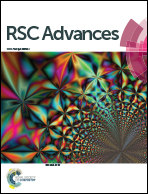Controlling ring-chain tautomerism through steric hindrance†
Abstract
We have explored the use of steric hindrance for favouring/hindering the tautomerisation of Schiff bases (SB) into tetrahydroquinazolines (TQ) in two systems that derive from the condensation of 2-tosylaminobenzylamine with two different aldehydes: 2,3-dihydroxybenzaldehyde (H2L1SB/H2L1TQ) and N-(3-formylpyridin-2-yl)pivalamide (H2L2SB/H2L2TQ). The four possible ring-chain tautomers were unequivocally characterised by a combination of 1H NMR spectroscopy, infrared spectroscopy, mass spectrometry and elemental analysis. Furthermore, two of the tautomers, H2L1SB and H2L2TQ, have been characterised by X-ray crystallography. Crystal data of E-H2L1SB have revealed the existence of a prototropic ketoenamine–enolimine equilibrium at room temperature that is the cause of the thermochromism of H2L1SB. A firm intramolecular interaction Ohydroxyl–H⋯Nimine hinders the conversion of the chain tautomer H2L1SB into the ring tautomer H2L1TQ. Crystals of H2L2TQ and H2L2TQ·HCCl3 consist of racemic mixtures of their enantiomers, C(R),N(R)-H2L2TQ and C(S),N(S)-H2L2TQ. A terminal pivalamide group prevents the existence of the intramolecular interaction Npivalamide–H⋯Nimine in the chain tautomer H2L2SB, favouring its conversion into the ring tautomer H2L2TQ.



 Please wait while we load your content...
Please wait while we load your content...